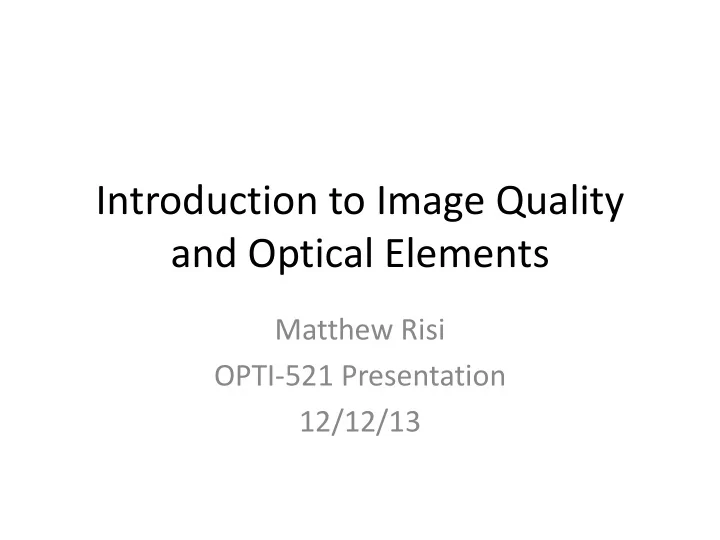

Introduction to Image Quality and Optical Elements Matthew Risi OPTI-521 Presentation 12/12/13
Outline • Introduction: Image Quality – What it is? How do we define it? How can we measure it? • The Imaging Equation • The Point Spread Function and the OTF – Effect of Wavefront Error • Sources of Wavefront Error • Consequences and Conclusions
What is Image Quality? • “I know it when I see it!” -Potter Stewart “ These corrections ... improve drastically the image quality. ” Anon Credit: Dr. Barrett’s OPTI-536 Slides
Something less subjective • MSE (mean-squared error) – No relation to object information – Insensitive to small features – Sensitive to irrelevant features (magnification, color mapping) Z. Wang et al. ICASSP, 2002
Something else less subjective • SNR or CNR (signal/noise , contrast/noise) “ The contrast-to-noise ratio CNR was used to determine the detectability of objects within reconstructed images from diffuse near-infrared tomography. ” “ ... a CNR of 4 is required for detection of the object. ” “ The CNR is a measurement of how well a region of interest can be separated from surrounding regions ... ” “ Higher field strengths are desirable for high-resolution imaging because the signal-to-noise ratio (SNR) is proportional to field strength, and the detected signal is proportional to the tissue volume within a voxel. A reduction in voxel size from 1 × 1 × 1 mm to 0.1 × 0.1 × 0.1 mm therefore results in a 1000-fold reduction in the detected signal. ”
CNR cont. • Figure from Dr. Barrett’s OPTI-536 Lecture • Courtesy of Matt Kupinski • Promising?
CNR cont. CNR 2.0 1.0 0.5 0.25
Task-based Image Quality • What information is desired from the image? • How will that information be extracted? • What objects will be imaged? • What measure of performance will be used? – Barrett and Meyers, “Foundations of Image Science” What limits your ability to extract information?
The Imaging Equation • g=Hf – Photography • f = discrete samples of an infinite series of points within object space • g = output pixel values – This convention lends itself naturally to the idea of a PSF (point spread function) • Consequence of diffraction • Ignoring geometrical aberration from here on out
The Point Spread Function • If the object is decomposed into a series of point objects, then the image may be considered as the object convolved with the system point spread function • Do a bunch of diffraction math to see that… – Coherent Imaging • PSF is proportional to the scaled Fourier transform of the pupil – Incoherent Imaging • PSF proportional to the square magnitude of the coherent psf
Diffraction Limited (Ideal) Imaging In a well designed imaging system, the size of the diffraction-limited blur spot will correspond to the size of a detector element D ≅ f/# W
Real Imaging • Aberrations in the lens cause wavefront errors (phase), W(r) • Rayleigh Criterion:
The OTF/MTF • Somewhat uglier math… – OTF (optical transfer function) describes contrast reduction of sine frequencies – MTF is the modulus of the OTF, represents ratio of output modulation to input modulation
OTF/MTF Cutoff • The maximum frequency that an imaging system will pass is: – Coherent: NA/ λ – Incoherent: 2NA/ λ • Caution: Detectors have their own maximum frequency (Nyquist sampling, determined by pixel size) and if your optical MTF extends beyond this frequency, you will have aliasing
Quick note: aberration polynomials • The OPD polynomial is one exponent higher than the transverse ray aberrations. – Third-order spherical aberration affects the wavefront proportional to the fourth power of the aperture – Third-order astigmatism is linear with aperture, and so the effect to the wavefront is quadratic with aperture – etc.
Sources of WFE • Surface curvature – How closely does the optic match a test surface? – Count fringes (must specify λ ) – Each bright-to-dark ring is W PV = λ /4 • Figure error – The magnitude of small-scale surface irregularities – W PV = (n-1)N/2 • N is # of fringes of irregularity
Other sources of WFE • Index inhomogeneity – • Temperature, Vibration, Deformation – No great RoT, use FEA (we can do that!)
W PV /W RMS • Wavefront Aberration W PV /W RMS Defocus 3.5 Spherical 13.4 Coma 8.6 Astigmatism 5 Random Fabrication Errors 5 – In a complex system, each lens should have on the order of λ /10 waves P-V error.
Conclusions: The Big Picture Credit: Sigmadyne
Conclusions: The Little Picture • Detector pixel size determines ideal f/# – Both for spot size and to avoid aliasing • Rayleigh criterion says to keep W PV < λ /4 – Have more complex forms relating WFE to PSF and OTF if we need them • This allowable WFE must be allocated, and we have several good sources for determining cost and feasibility of tolerancing
Example RMSWFE Budget Credit: Keith Kasunic, Optical Systems Engineering
Questions? Misc. References/Resources: OPTI-536 Course Slides – Dr. Harry Barrett Foundations of Image Science, Barrett and Meyers Optical System Design, Robert E. Fisher Optical Systems Engineering, Keith J. Kasunic
Recommend
More recommend